Incorporating the best practices of SEO content when developing your website is an investment that will pay for itself many times over.
A basic awareness of how a page ranks will insure your content is being crawled and indexed by search engines.
By applying the general rules of optimization and publishing high quality content your business will be able to cover a substantial portion of what it will take to drive traffic to your site. Before you start looking for online writing help we advise you to look through our manual.
Audit your site
The first step to making sure your pages are being crawled and indexed is to perform a site audit. Use a tool like Screaming Frog and simply enter the URL of your site in the dashboard. The software will crawl your site just as Google would and produce a report on the technical aspects of your website.

Within the summary you will find the URLs that have been crawled as well as the URLs that have been no-indexed. In addition to any indexing issues, the report will reveal any duplicate content, broken links and code errors that may be affecting your sites performance.
Research your ranking options to build your foundation
Choosing the best keywords for your site is a research process that can be broken down into three phases: create topic clusters; generate keywords options; and group keywords by search intent.
Topic clusters
Create a basic blueprint for your content creation by describing your main keyword topic with the subtopics that make up the different aspects of what it entails. If your company offers interior renovations, then the subtopics within your main page would most likely include, bedrooms, bathrooms, kitchens, basements etc.
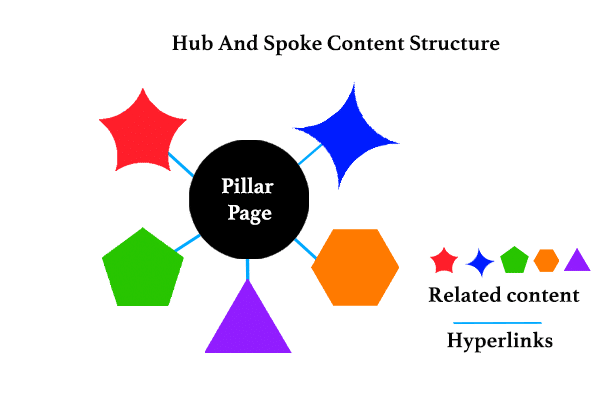
Although you would need to describe the service your company provides within your main page, each of the subtopics mentioned would require a completely separate page to go deeper into detail on that particular aspect of renovations. This is the basic pillar page model to provide depth your content for your main keyword topics.
Generate keyword options
The next step in choosing your keywords is to take each of the subtopics that make up your main keyword topic and enter the seed keyword into a keyword tool. This will give you an overview on the volume and keyword difficulty of the different variations of your seed keyword.
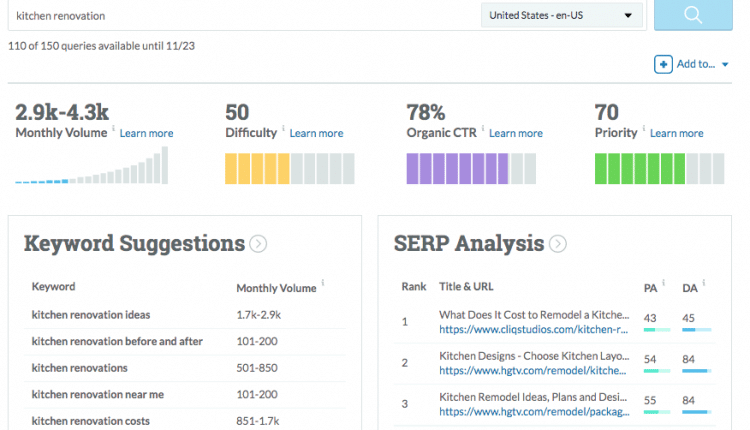
Filter the terms by eliminating keywords that are not within your range to achieve a first page result. Make your decision by comparing the number of backlinks and page authority to your own page (the pages on your site are automatically assigned a default page authority based on your domain authority). This will give you an idea of how many links you would need to acquire to get to the first page of results.
Make your keyword a long-tail key phrase to narrow the possibility of user intent and reduce the level of competition. Your page will attract higher converting visitors when the focus of your keyword is more specific describing your content.
[insert page='why-a-free-seo-tool-junkie-finally-joined-the-paid-club' display='single-related-article-02.php']
You can finalize your selection by confirming what is popularly searched on the first page of results. Type your keyword into Google search and 90% of the time you should get a PAA box (People Also Ask). List the questions that appear as options for your title as well as potential headings within your content.

PAA boxes represent potential traffic opportunities that you can optimize for by providing a direct and succinct answer to the question. If the question includes your target keyword you can make it your headline to give you page the best chance to rank in the PAA box as well as in the organic listing.
Make a list of the questions that add value to your content as they too will provide relevance to your main target phrase.
Group your options by intent
By now you should have a large list of options that have been generated by the keyword tool as well as the long-tail options from PAA boxes. Scan through your list and assign each keyword a group that could be used within the pages you’re creating on your site.
Many of the keywords will be variations to that contribute to the optimization of your page by using them in your content. Keep an eye out for frequent searches on related topics you haven’t thought of that could develop into a page of interest.
Publishing pages on related content extends the web of connected ideas that you’ve outlined in your topic cluster. This creates additional depth in your topic and increases your potential to satisfy the search intent of a related query.
[insert page='top-10-best-online-plagiarism-checker-tools-and-websites' display='single-related-article.php']
Create content for your audience
The cluster model is the basic blueprint for your content creation. For every article you should have a target keyword along with a cluster of variations and synonyms to use within your content.
Create content with the user in mind. If you’re effectively satisfying user intent, it will be reflected in the search results by demonstrating positive engagement statistics.
You can increase the level of engagement by researching places that would provide additional insight to the most common problems and issues people are experiencing. Search forums and social groups for discussions that get a lot of comments and responses, as these will be the issues that are more likely to resonate with your audience.
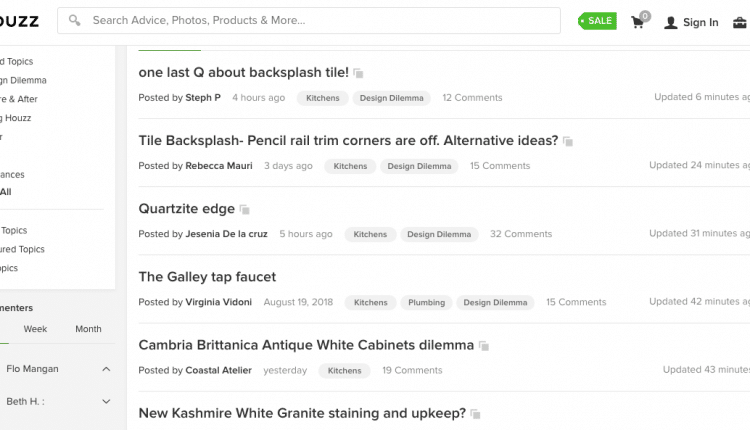
Image source: Houzz.com
Discover gaps in content coverage by identifying the keywords your competition is ranking for. Pages that rank on the first page for one keyword will often rank for multiple keywords. These missing keywords represent content that is ranking for separate keywords, however this content is also contributing to satisfying search intent and should be considered for your own article.
To find out what keywords your competitors are ranking for you can use Link Research by Moz. Type in the URL of the competing page in the Link Research tab. A summary of the URL will appear with a box indicating the number of keywords the page ranks for.

Click on the number highlighted in blue to see a list of the keywords.
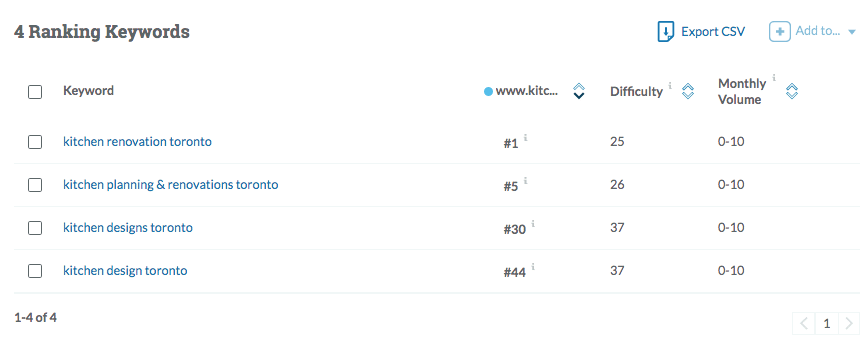
Another way to engage your visitors for a longer period of time is to use a video. Videos are the preferred method of learning and will encourage more visitors to get through your content with a little more ease. The added time visitors spend on your site will contribute as a positive ranking signal and potentially move your site up in ranking.
Optimize your content
Your on-page optimization will serve to break any barriers in communication between your site and search engines. Place your keywords in the correct places to make it clear what search phrases your content should be associated with.
Your target keyword should be included in the title, URL and the first paragraph of your page. Use keyword synonyms in the subtitles and wherever it makes sense throughout your content as long as it is natural and not forced. Optimize for the PAA box and any featured snippet that exists on the first page of results.
[insert page='the-10-best-content-marketing-tools-you-need-in-2020' display='single-related-article-02.php']
Write for users, not search engines
There are hundreds of factors to consider when ranking a website however none are quite so important as the content you publish. A solid strategy for content creation that includes SEO best practices will lead to more success in driving traffic to your website.
Is it possible to conceive of a digital marketing strategy without content marketing? The answer is no. The truth is, traditional marketing has been slowly making way for digital marketing. Customers are no longer impressed with product pitches; rather, they are keen to try brands which offer them consistent and useful content that can help resolve their problems.
According to Neil Patel, as many as nearly 88% of B2B marketers are using content marketing in their digital marketing strategies. So, if you are still not a part of this lot, maybe you should reconsider your decision. Those who have incorporated content marketing in their marketing strategies are obviously well aware of its benefits. It is reassuring to know that there are plenty of marketing tools out there which can make this journey smooth for you.
Why do brands focus on content marketing?
Brands which do not focus on pitching their products only are what catch the modern consumer’s eye. And this is what makes content marketing so crucial. Businesses of all sizes use content marketing as this keeps the customers satisfied and guarantees better conversion rates. You can enjoy cost-savings, higher sales and more loyal customers if you can take advantage of content marketing.
To attain goals of content marketing, however, you must get reliable platforms. These will enable you to carry out an in-depth assessment of the existing content and they will give recommendations on how to enhance content quality to optimize its impact.
One such popular platform is SEMRush. This has proved to augment content marketing strategies through tools for content auditing, post tracking, and SEO content templates. Marketers can be both analytical and creative when they use this tool and its features enable them to complete their content marketing workflow in one place.
[insert page='step-by-step-guide-to-keyword-research' display='single-related-article.php']
How can you benefit from SEMRush?
With this tool, you can discover trending ideas for discussion. You are able to create catchy content which you can then optimize. The tool also lets you manage the editorial plan and assess content performance. By learning how to use SEMrush, accelerate your content marketing efforts.
Content Audit Tool
This tool will enable you to audit the quality of your content on the site pages, based upon sitemap data. So, you get to know which web pages are more effective than the others.
- You can data like social signals from Facebook, Twitter, Google Plus, back links, user signals, and average duration of sessions, bounce rates, and number of sessions.
- The tool will also collect content authors, metadata, and length of content for every URL. Using these metrics, you can identify pages that do not get the viewership they deserve. You can then consider improving them with an update.
- To get this done, you may click on the “Content Audit” option under Content Analyzer. When you press on the “Start Audit” option, the tool will begin gathering data for you.
- When it generates a report, you must detect the loopholes and errors on your site. You can do this faster by identifying content through back links or social shares which are not popular as the content on other pages.
- You may also find web pages which are very old and need to be updated.
- Finally, you can find content which may be lengthened into longer posts after assessing the word count.
- Workflows can also be managed using this tool as it lets you track progress for every page on the site. You can choose from options like “Not Done”, “In Progress” and “Done” to prioritize the pages that you wish to improve.
- You may even take URLs and enter these in the On Page SEO Checker for getting actionable ideas that can help make your strategy better.
[insert page='are-you-confusing-your-requirement-for-a-99-tool-with-a-999-seo-agency' display='single-related-article-02.php']
Post Tracking Tool
The SEMRush post tracking tool lets you assess and calculate the performance of articles through tracking elements like back links, social shares, and keyword rankings. This tool can also be used for tracking the performances of guest posts on various websites or for reviewing articles from contender sites. The tool can be accessed from Content Analyzer too. You would need to type in the article URL to get started. You may learn how to run the tool from a demo mode that is provided with it. This tests three sample URLs. In a matter of seconds, the tool analyzes the URL typed in by you and returns a report. This shows the article back links, keywords, and social shares. When you view social shares, you can see the top Twitter contributors for this article - who have either retweeted or shared it. This input helps you to conduct an influencer outreach as you promote your content vis-à-vis your competitors’ content.
SEO Content Template
This is a standalone tool allowing content marketers to create SEO friendly content. Its main aim is to help you come up with content that can outshine your rivals. It will uncover link-building opportunities for you and you can find out how your biggest rivals are making use of target keywords. The tool is available in a navigation menu under “Gap Analysis Tool”.
To use this tool, you must enter the keywords and choose the location. Then you need to click on “Create SEO Template” after which SEMRush will produce a report containing data such as key recommendations of back links, video content, semantically-related words, text length, etc. It is possible to export this template to a document in Microsoft Word for accessing it offline. The document will have recommendations for meta description, page title, back links, and text.
[insert page='get-a-ringside-view-to-competitive-strategies-with-your-semrush-marketing-toolkit' display='single-related-article.php']
SEMRush turns out to be helpful every step of the way - whether it is planning a broad marketing strategy or finding metadata for your web page. You can even sign up for a free 14-day trial to see if the tool can give your business the jump start it needs. It has a phenomenal power to identify profitable keywords, no matter what the niche, and it can offer better competitive data than any other content marketing tool. The tool offers 3 types of pricing options, namely, Pro, Guru, and Business Plans. SEMRush seeks to identify who your organic competitors are in order to see what they are doing and to make sure you can do it better.
Here I’m going to make the case for a focus on optimizing organic growth traffic to generate the leads of faithful or repeat visitors that have genuine interest in your platform and content.
Many reasons exist as to why this strategy should be added to any content marketing strategy, and by the end of this article you will have leveled up your ethical, organic marketing skills and wisdom.
Author’s Note: At the bottom of the article, we’ll also go over some great strategies to increase organic traffic and improve the loyalty of existing traffic that you probably would not have thought of.
There are a number of strengths that organic traffic possesses which other kinds of paid traffic do not.
Templates for different growth strategies for your business can include paid media, shared media, owned media, and earned media. Optimizing organic traffic is one part owned and one part earned.
- Owned traffic is growth you’ve earned with your hustle, energy and effort, and consists of things like a well-developed SEO content marketing strategy or keyword ranking, as well as personal brand outreach and development like email marketing or in-store promotions.
- Earned traffic comes from things like getting the word of your content out onto the plates of influencers, authorities in a domain, review sites, blogs and other media outlets.
Where does organic growth and traffic fit in the marketing picture?
The strategies for growing the interest in your platform, content, physical store address, or blog, are in theory numberless. As there are now 7,400 possible platforms, apps, and tools available to the content marketer, segmentation of growth strategies are endless.
There is one that is evergreen however, as it represents the world’s oldest content marketing strategy, and maybe even the world’s oldest profession (no, not prostitution). It involves capturing loyal, returning, organic customers or visitors and building a relationship with them like the vendors at the community farmers market would do.

PICTURED: It is in the ancient Mesopotamian city of Uruk, reckoned to be the second-ever city in the world, where pottery was likely developed en mass. Some artifacts still carry the ancient potter’s “maker’s mark,” stamped onto the wet clay with a cylindrical seal bearing his name – the world’s first form of branding.
While we’re on the subject of historical content marketing anecdotes…
Did you know?
The Canadian rock band Rush famously produced 2112, an album with a twenty-one minute single in an era where radio singles were limited to around 4 minutes in length. They were determined not to let record companies infringe on their creativity, and it is generally considered that the album’s incredible success, since it wasn’t played on the radio, was due to loyal fans organically telling people about it.
The last part in this series we’ll go over some unique and exciting ways you can enhance your organic growth strategy by making sure your customers feel they are entering an ethical business or platform.
[insert page='get-a-ringside-view-to-competitive-strategies-with-your-semrush-marketing-toolkit' display='single-related-article-02.php']
Just quickly, I want to lay out some easy things you can do to increase organic traffic before I explain why the case for the oldest content marketing strategy is so strong.
- Put continuous, unerring effort into making your product and processes as memorable, factually correct, and high-quality as possible.
- Be honest and explanatory in every interaction you have with your customers, viewers, readers etc.
- And lastly stress in all things that what you’re offering is valuable and not just some useless data taking up space on the internet.
I’ll be making an operational, moral, and financial case for organic traffic since I’ve already made a historical one, though not so much as to say other forms of traffic aren’t worth chasing – as they most certainly are in some circumstances, and for certain reasons.
An Operational Case For Maximizing Organic Traffic
“What could be better for operational capacity than steady, expected, daily traffic which doesn’t have to be found, herded, or paid for?”
Yes, depending on the success you have in attracting good quality organic traffic to your website, platform, or physical address of business the less pressure on your marketing, writing, or content teams to succeed.
If you have a physical address, the cost of doing business is often higher than simple e-commerce sites, and so having a revenue source you can count on is all the more important.
In the world of digital or content marketing, few things are certain, therefore having something that is can change your situation, and shift pressure away from certain departments, campaigns, or individuals.
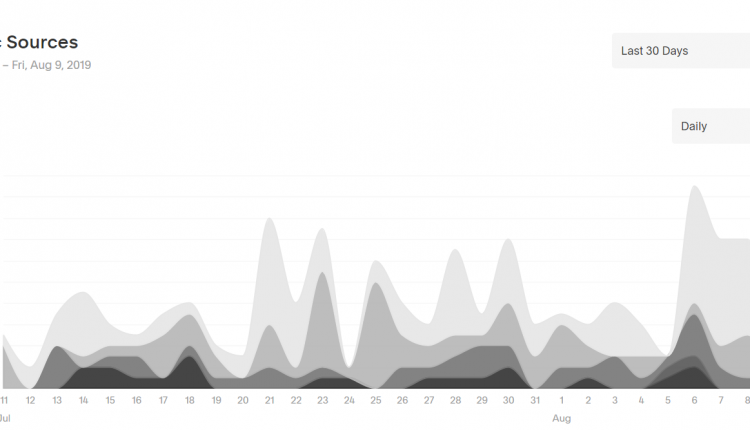
PICTURED: Squarespace analytics of a typical website’s traffic, where the lightest shade of grey represents organic, owned, returning traffic and the darker shades are shared, paid, and earned traffic.
Organic traffic gives you wiggle room
In order to give yourself or your employees the niceties afforded at other offices – such as sick days, paid or unpaid leave, having organic traffic which you can expect to be there can make up for that lost time.
New projects, for instance the launching of a new platform, the expansion into a new social media domain, the implementation of new software, or the launch of new marketing campaigns can be carried out slowly, methodically, and thoroughly – without the need to rush through them if you have that background traffic source which you can rely on.
Finally organic, returning traffic that values your content or products represents the perfect sample study for any new products, processes, or services you want to roll out.
Including them in a free trial, sample, giveaway or other promotional event will help increase their loyalty and make them feel they are respected and appreciated while also providing you with good quality and actionable data on any new products you launch.
Thus we have a case for the benefit of operational capacity and possibilities by optimizing organic traffic.
[insert page='10-must-have-content-marketing-apps-tools' display='single-related-article.php']
A Financial Case For Maximizing Organic Traffic
As mentioned above, steady financial input is something that doesn’t just improve the earnings column in your taxes, it allows for the wiggle room which is responsible for almost all innovation in business.
[bctt tweet="“Organic traffic is the grease between the gears of innovation and growth.”" username="relevance"]
Maximizing organic traffic and growth in 2019 is vital for a team to be able to make appropriate estimations and guesses on what kind of changes and innovations you should or could or would be making.
Exploring the avenues into which a run at optimizing organic traffic would benefit you can be really important for tapping into unorthodox forms of income.
Here are some unique ways organic traffic boosts your ROI
- If you’re a non-profit, organic traffic is going to represent the kind of people who make donations and recurring donations on Patreon or PayPal.Such funds are not going to come through people who read one article which shows up as an ad on their Facebook wall or Google search. If you plan to monetize a project in part through donations, organic traffic is a must.
- One of the most overlooked and hardest to track forms of traffic are the clicks and purchases that come from personal, word-of-mouth recommendations between friends. Remember our example with Rush and 2112 from earlier?And if you think about it for a moment, you’ll realize the only time one does this is when it’s a product one truly believes in or appreciates.
- Organic, returning traffic is the only kind of traffic which can consistently work as 4th party marketing nodes out on the market landscape, distributing information about products, services, offers, or content to other people with whom they have a personal relationship with.
This is perfectly summed up with the enthusiasm found within the sub-Reddit /r/buyitforlife, a forum of people sharing their favorite brands and products which are both indestructible and always reliable.
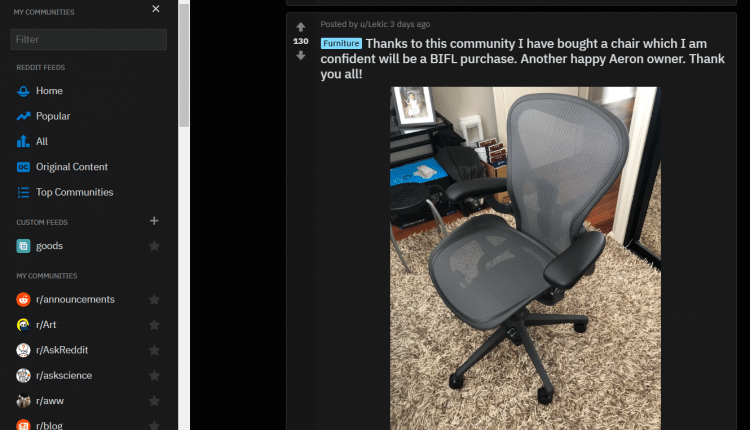
PICTURED: A typical post in /r/buyitforlife where this poster has literally bought this chair based on free-exchanges of information between like-minded consumers. These are traffic sources that are valuable, free, and almost impossible to track.
A Moral Case For Optimizing Organic Traffic
James Otteson, author of Honorable Business: A Framework for Business in a Just and Honorable Society, outlines that all the wealth in the world has been at some point, extracted out of nothing through one of two ways.
- The 1st is through what is sometimes called a non-beneficial transaction, also sometimes called extraction. This would be something along the lines of robbery or taxation – a kind of transaction that isn’t mutually beneficial or agreed upon.
- Markets, says Otteson, are made stronger by repeat action of the 2nd way value is generated; a mutually-beneficial transaction, in other words, capitalistic acts conducted by consenting adults who both stand to improve the overall value in their possession.

PICTURED: Author James Otteson, speaking at Notre Dame.
Optimizing organic traffic isn’t just good for ROI, it’s the right thing to do
[bctt tweet="Businesses perform best in an environment where people have as much incentive and capacity for mutually-beneficial transactions as possible." username="relevance"]
Even in the situation where no monies are being exchanged, as is often the case with online enterprises, services and goods of non-descript value actually are, in fact, being exchanged.
Take for example the journalist.
What the loyal reader might acquire for free by reading his column in The Atlantic allows the journalist to make money through his employer.
Furthermore, of what intellectual value is that freely-offered property (the column) to the reader?
Since being properly informed on current events these days is tantamount to a skill set, there actually is a fair bit of value going from writer to reader, even though no monetary value is being exchanged.
This is a favorable exchange for the reader, and so it becomes easier for him to become part of your organic traffic – which is best achieved in a favorable environment for business – i.e. a climate where those visiting your platform are incentivized to make a mutually-beneficial transaction that leaves them feeling positive about taking the action.
[insert page='10-best-email-marketing-services-software-for-2019' display='single-related-article-02.php']
What a marketer ought to do: Methods of Growth
It is precisely creating this environment on your platform that allows for the maximal acquisition of organic returning traffic. Holding a standard of business ethics and morals towards those visiting your platform or physical address will give you the best chance of enticing them into return again or tell their friends about you.
Paid or low-quality traffic has no reason to get to know your platform as an ethical business practice or source, and so exists as an unlikely target for many useful advertising, monetizing, or growth strategies.
Here is the first creative and unexpected way you can make certain these values are imparted onto your visitors.
Be an identifiable person
- Pick an individual from your team, or yourself if you operate the entirety of the business alone, and begin to use pictures of their (your) face across your platform for different purposes.
- If you have a newsletter or send out marketing emails, put a professional headshot as a lead in, with actual words that person has said.
- Have a section on each page of your website with the selected headshot, and a word for word explanation, welcome, or other kind of dialogue next to it from that person.
- Include a regularly-checked email or phone number for visitors to reach out to. Whether they do or not, you’ll always be able to maintain a strong semblance of personability with your visitors.
This way, an actual business person is guiding the visitor through the website experience, setting precedence for honorable conduct to come, and making such they feel they are interacting with an ethical business platform.
Neil Patel’s blog is a shining example of this practice. His big ears and jolly face are everywhere you look, and it reminds you there’s an actual person out there.
In the establishing of a solid, morally positive source of organic traffic, one can reap all the benefits listed in the previous chapters, while also maintaining that part of you which is grounded in the desire to treat people with dignity and justice while conducting business in as honorable a way one can while pursuing the goals of amassing value and capital.
Create an ethics or mission statement page; make it easily visible
Here is the second method that can help your audience organically grow by practicing honorable business.
- Create a stand-alone page on the ethics and values you promote through your blog, business, platform, or brick and mortar store. Make sure it’s one of the primary pages in your navigation menu or bar.
- Create a call to action on your home page with the label “Our Values” or “Read the Mission Statement”. Don’t be afraid to create a moral code as a way of driving organic traffic.
- Create specific referral links to products, articles, or services FROM your values or mission statement page. This provides a dual purpose of helping those reading about your goals along to becoming converting leads, as well as letting you know how many people are inspired by your values into taking an action, and how many people would take them regardless.
Strive for perfection
If you aren’t set up for success, you won’t be in a position to capitalize on any strokes of good luck which come your way.
We walked about rocks bands earlier, well there’s a saying amongst rock and roll musicians that’s something to the effect of “You’re here to put on a show, whether for 10 people or 10,000 people.” Some other ways I’ve heard that are…
- Perform for the bartender and you’ll never be disappointed by a small crowd.
- Always pretend there’s a record executive at the bar that night.
- Perform the same way no matter the size of the crowd.
Simply put, if a person organically stumbles upon your website, and you haven’t been making an absolutely effort into providing quality products, services, or articles, then you’ve lost the chance at earning some organic traffic.
- Whenever you write an article on anything, write this on a post it note next to your computer and make sure you believe it: “When this is finished, it will change at least 1 person’s life”.
- Put every effort into making sure your content is of the highest quality. One of the ways you can do this is by constantly asking for feedback.
[insert page='how-long-should-your-posts-be' display='single-related-article.php']
Know where the best places to attract organic traffic are
One more quick method for maximizing organic growth and traffic is to understand where high-quality traffic is most likely going to be spending their time on the internet.
- Find high-quality blogs and publications that place equal value in content quality and ethics within your field or domain.
- Try and publish articles off-platform, meaning on these high-quality blogs, to lend your own site more credibility and traffic.
- Avoid using the social media platforms, or spaces within those platforms, frequented by poor-quality traffic or saturated by people who are more interested in conflict, low-engagement content like gifs and memes, and poor-quality shopping experiences.
In conclusion
Now you know and have a good grasp on what is required to make an excellent effort at increasing organic traffic.
Remember the moral, financial, and operational capacities for optimizing organic traffic, and build a solid predictable and reliable base to build your platform or business on.
What is web traffic? Web traffic is the data received or sent by users. It is one of the largest portions of internet traffic. Technical SEO on the other hand is a process used to achieve higher search engine ranking. It includes optimizing crawling, adding web search to Google pages and using software that renders HTML pages. Use these tips to improve your technical SEO and watch for an instant boost in web traffic.
Correcting a defective outdated blog post
Correcting your blog posts is a simple and effective process. One uses any element or feature that will make relevant and improved changes which are unique. You start by finding a certain blog post with irrelevant and outdated strategies that you plan to correct. The tips or information which are no longer relevant to the subject are replaced with the updated trends in the SEO. A good example is that of Brian Dean who used certain elements to increase traffic to his site by around 50%. The elements he used were:
- Statistics
- Infographics
- Screenshots
Use of Latent Semantic Indexing (LSI) keywords to optimize your blog post
The LSI keywords are those keywords or phrases which are related to your keyword.
Keywords are optimized by including them in the title at the beginning of the heading, and within the first sentence. The ranking of the blog post is more likely to be high if you can manage all three. Once the keyword is typed, the best performing pages will display it at the beginning. Keywords can be used several times in an article but in this case one must make sure that it’s mostly placed at the beginning of the sentence and that it sounds natural and not a cliché. Google search makes it simple to find keywords. An LSI graph is a tool that shows you if you have enough keywords in your blog post.
Keywords can optimize blog posts through;
- Use of relevant keywords. Keywords should not be overused to avoid going beyond 1.5 % which is the appropriate keyword density. Keyword density is the percentage of how many keywords or keyword phrases have been used in web context compared to the number of words contained in the article.
- Use of catchy headlines to make the content more accessible and easily understandable for the audience.
- Make your article easy to read and understand.
- Make the content you use to go hand in hand. This is called Yoast SEO. This will help you analyze your post and improve in certain areas in order to improve your SEO.
- Use the on-page SEO
- Use the off-page SEO
Use influencer marketing to boost traffic
Once an influencer has recommended your product or service, tons of organic traffic is created due to their position as an influential voice in a domain. An influencer has a positive impact in:
- Improving SEO.
- Boosting social media shares.
- Building quality backlinks.
- Improving the Google search ranking.
Use a question analyzer to increase traffic
This method allows you to figure out and to answer the questions that your target market poses, thus creating targeted blog content that answers questions specific to your audience. The questions help the blogger write a compelling article that will add a lot of traffic to the website. One finds questions that are relevant to the topic and the ones which relate to your niche market thus creating content around those questions. It is also easier to update your old blog posts by using the answers you gleaned from your question analysis. .
Optimize your website for mobile
Mobile phones are nowadays more often used to conduct Google searches. Almost 60% of the internet searches are done using mobile phones. Searches now show that Google favors mobile networks over desktop versions. This 60% figure comes at a time when Google has rolled out a “mobile-first” indexing strategy. Therefore, it is important to use the Google mobile-friendly test tool to check how well your website is optimized for mobile. Making sure that your blog or the website itself is more optimized helps in increasing one’s website traffic.
How to use the Mobile-Friendly Test Tool:
- Start by opening your app and typing the URL and hit the run test button.
- This is the result of your test. When some issues rise one must rectify them by checking that the site one is using is up to date. This is done through checking the Google mobile updates.
Leverage the LinkedIn publisher
The LinkedIn publisher is an important platform where you can post your articles and where a wide range of people will see the post. Posting a blog informs your first LinkedIn connection through a notification which is sent to them. If your post is interesting, your connection might read it, and maybe even share it.
Use different formats for your post
Traffic can be increased by transforming the blog post into different content with different formats. Context can be consumed in different ways by the use of different features, the most commonly used features are videos, e-books, infographics, and podcasts. When this content is used, your website traffic increases.
Rank videos on youtube
Youtube is an open platform where everybody can engage in entertainment and in ranking.
Here is a simplified way of making ranking videos;
- Use a YouTube keyword tool this way you can create popularity.
- Publish the content and promote it by answering to all the comment posted.
- Have a high engagement video detailed with search intent.
- Have a YouTube on page SEO video optimization
Posts which appear to be similar should be merged
A good example of merged posts with URLs is;
- com/blog/how-to-drive-traffic-to-your-website/ and
- com/blog/increase-website-traffic/
Before merging,

Initially it was seen that when they were each on their own, they never got much traffic. Once they were merged using a technique called cocktail technique.
After merging,
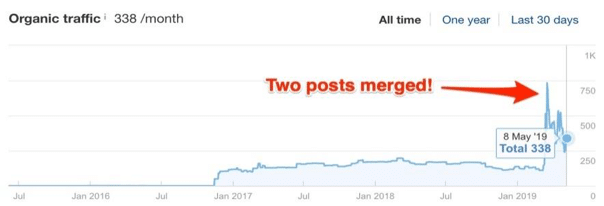
Having an SSL is an Immediate Assurance
One of the best and final SEO tips we can mull over is having an SSL certificate on your website. For better SEO ranking, SSL is now a necessity. Now even Google has made SSL compulsory because it helps in search engine ranking. Moreover, if the website is accepting online payments, then Cheap SSL is an ideal option to secure transactions as well to establish a reputable online presence towards customers. When customers find your website as a secured site, they are more likely to purchase from you, and in the long run, help add more traffic to your site.
Finally, we can ascertain that the above tips will surely help you to increase traffic on your website. Besides, there are other things like social media ads, content promotion, guest blogging, email marketing, data analytics helpful in boosting website traffic.
This Beginner’s Guide to SEO was created for beginners; those who are interested in getting to know everything about SEO, but haven’t the time to delve through dozens of articles in order to do so.
SEO is a buzzword in our day, but not many people truly understand what “search engine optimization” really means, and even fewer people have an awareness of what is entailed to improve the SEO of a given site.
If you’re interested in learning more about SEO and how to optimize your site, read this beginner’s guide to SEO.
Step #1: Choose the Right Keywords
If you are a small company, it is less likely that you’ll rank quickly for big keywords (if you’re doing things legit). Therefore, although you’ll want to put in huge keywords once or twice, focus more on the less popular ones which you’ll be more likely to rank for.
If possible, utilize Google’s Keyword Planner to find keywords to target; that’s the best way to find the optimal keywords.
Step #2: Write The Best Content Around
You’ll only rank above others if your content is better than theirs. Write, write, and write some more, and don’t ever skimp on quality. Make sure your content is useful, and never commonsensical.
Check who is ranking for the keywords you are targeting, and write better content than them: more informative (you can do this by putting together all the information you can find online on the topic; not just taking from one, and this way, you’ll have more content than anyone), and more interesting.
Post an original relevant YouTube video to the page, and add pictures or an infographic wherever you can: The more interactive the page is, the more likely it is to rank. Basically, the key here is to make sure you have “10x content”- content that is 10 times better than anyone else’s.
Step #3: Get Links
Getting links is not a simple process, but it’s mandatory if you want your page or category page to rank. And not just any links will do; you’ll need links to quality sites. For example, let’s say you want to get your hospital bed pad page to rank.
The first thing to do is write great content about these underpads; better than anyone else’s on the topic. Once you’ve done that, you can start attracting (or soliciting) links going to that specific page.
You need other people to link to your page so that Google sees others think it is authoritative and has value. If others are linking to your page, that means your page is pretty popular, right? So Google wants to show people the popular choices: Like yours.
Here’s a link to a post about how to get links.
Step #4: Do Your Site Right
Make sure Google is able to crawl and index your site. Ensure your site is https and not http. You can check this by typing your domain name into Google Chrome, and if you see the word “secure” pop up, followed by https, your site is secure. If not, work on getting an SSL Certificate.
Check that your site has a normal speed, and doesn’t take too long to load. These are just a few common technical SEO issues that can prevent your site or page from ranking.
Step #5: Keep Up the Great Work!
SEO never ends. It’s a continuous process; for Google to see that your site is still relevant you need to be putting out new content, creating new pages, getting more links, and continuously optimizing your site.
Keep it up and your site’s rankings will rise.
It doesn’t happen with the snap of a finger; it will definitely take time to rise in rankings, but this is the tried and true method for getting and staying up there.
At this stage of the game, companies understands the value of investing in organic traffic to their web assets. Unfortunately while a non negotiable strategy, SEO continues to be one of the most misunderstood marketing channels in the business and therefore routinely outsourced without a clear understanding of the WHY
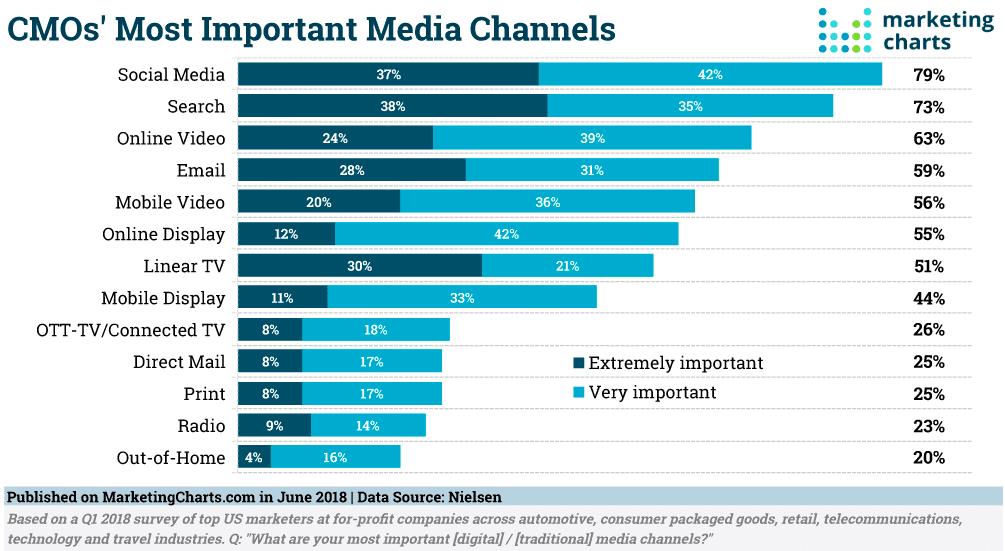
In this article let's examine the pros and cons that you may want to consider before handing off one of your most strategic marketing weapons to a seo agency.
Pros of outsourcing SEO
Focus
Entrusting a crucial part of your marketing to a specialist agency allows you to focus on the things that you do best. These could be sales, leadership or even other marketing channels. In trying to do everything at once by yourself, you may not reach critical mass in any.
Good SEO will also need staying abreast of algorithm updates, advanced SERP features as well as constant monitoring of ranking progress which requires time and dedication, something only a specialist can provide.

Source : https://bathrin.wordpress.com/2016/06/21/google-algorithm-timeline-2016/
Efficiencies
Agencies have the benefit of volumes and therefore assembly line processes that allow them to research, identify and create content assets and link networks more efficiently.
Running an online survey for one brand on one platform requires almost as much time as running it for several brands given that the time investment is mostly in understanding parameters and setting up the campaign. The same logic is true for creating social profiles or directory submissions. Agencies give you volumes that internal teams cannot.
Navigating troubled waters
Partnering with agencies also provides access to multiple tool insights ( subsidized over several clients). Experienced industry experts can provide advice that can really save the day when traffic nosedives for no apparent reason.
If only to hear “ It is completely normal for keyword ranks to fluctuate by x%”, it is great to have an expert on call when you are unsure of what is happening. Truer still when the discipline lacks any real body of data that you can refer to in times of crisis.
[insert page='step-by-step-guide-to-keyword-research' display='single-related-article-02.php']
Those were the pros..Now for the Cons of outsourcing SEO
Weak cross channel integration / leverages
SEO, SMO, SEM, Email marketing, Lead generation, Inside sales…etc. are NOT watertight silos that function independent of each other. They need a common strategy and feed off each other’s wins and failures. In a fast changing ecosystem where agility is paramount, it can be suicidal to delay inputs from or worse cut off the SEO feed entirely.
Again, some risks can be mitigated by continuing to monitor search analytics or frequent updates and meetings but the advantages of having all digital teams in one workspace, sharing inputs and planning campaigns together is invaluable to the success of a campaign.
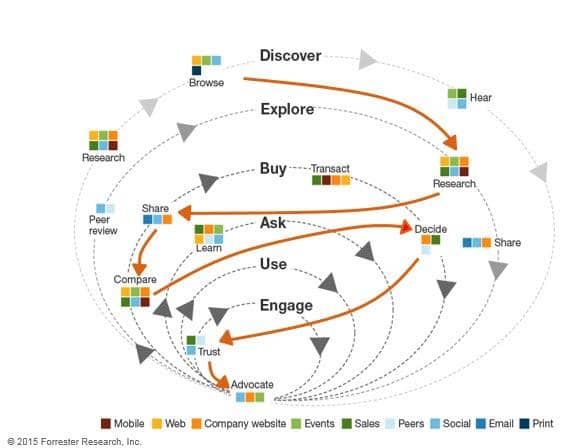
Source : https://blog.hubspot.com/marketing/seo
Weaker domain/customer insights
The foundation stone of any successful SEO program is based on target search strings which comes from a deep understanding of the customer segments. External consultants, however senior do not live and breathe a brand like an employee. They may lack the intuitive insights available to an internal team.
You could circumvent this risk by spending time and effort in the quality of your brief and transactions but it’s never the same. An external agency may know SEO better but will never understand the brand better than an employee. The tradeoff is real!
Agency bias in progress updates
Or what I like to call the “ The agency dilemma”. Agencies work on a retainer. This means that they NEED to show progress month on month regardless of the very real constraints posed by the algorithmic updates, competitive spends, last minute keyword modifications or delayed approvals. At the very least, they have to package and sell the information as a win. This often translates to short term hacks, misinformation and in cases, damage to long term SEO prospects.
There is no real workaround to this except being conscious and aware of the nature of the partnership and the underlying risks. There is no motivation for an agency to hurt a brand unless it is to protect one’s own. Be cognizant of that reality and tread accordingly.
So while you can outsource your security, your payrolls and definitely your catering, agencies are not always the best solution for achieving SEO success.
Even as evaluate the factors in your unique scenario, I would suggest the below regardless of your final choice.
1. Invest in a marketing toolkit
SEMrush, MOZ, Ahref and even the humble Google Analytics provide insights and bubble up issues keeping you abreast of progress on key success metrics. In addition you can pull out keywords rankings , competitive performance as well as stay aware of any major fluctuations in traffic performance. This gives you first hand access to your brand performance.
2. An owner for your SEO in-house
Till the point you decide to outsource this person can manage basic optimization, escalate issues as well as run and analyze reports from the tool that you have invested in. Once you do bring in an agency, this same person can liase with them to provide inputs as well as ensure that efforts are integrated across channels. There is no reason why the same person cannot be responsible for social or PPC given the scope of activities planned.
3. Common marketing goals
SEO is just one pointy tool in the box to help you achieve traffic, conversions or brand visibility. Ensure that all teams - in-house or outsourced are aware and understand your bigger marketing goals. These could be the event that you have to fill seats for or the PR needed for the CEO’s visit. This ensures that all efforts are cross leveraged and amplified for maximum efficiency.
We would love to hear your experience with “ To outsource or not” in the comments below.
Proper search engine optimization (SEO) is of vital importance for any successful online business. Whether you’re offering products, services, information, opinions, or any other valuable content, you need to be on top of current SEO trends.
Having some simple business sense is a good step in the right direction: you’ll need to know who your target audience is and what they want from you, and then produce valuable content accordingly. Link building is still a great way to become an authority in your area, and it’s great to optimize your site for search engine crawlers.
But if you’re neglecting local SEO efforts, then you’re really missing out.
[insert page='10-local-seo-tips-tricks-for-small-business-owners' display='single-related-article.php']
The following are some essential local SEO tips that will help you engage with customers like never before.
Optimize for all users
First of all, you need to have your site optimized for all users, especially mobile ones. Your site needs to look pleasant and be convenient to use on mobile devices, especially considering that well over half of web searches come from mobile users.
Mobile searches tend to prioritize local results, and users are much more likely to contact a local business if their site is mobile friendly. Google has test tools available online to check your mobile friendliness.
Google and beyond
There’s no doubt that Google is the dominant search engine, and roughly 46 percent of searches are local. This means that you’ll definitely want to set up a Google My Business account.
This gives you the chance to impress customers with your business profile when they search for local businesses, and you can easily connect with them via Google Search and Maps. It also makes it easy for customers to reach you through a variety of methods, so you’ll be able to do more business.
Of course, local SEO isn’t just about Google, but it’s a great place to start since the vast majority of potential customers will be using it. Still, you’ll also want to optimize for popular alternatives like Bing, Yelp, and Apple Maps.
[insert page='how-to-rank-your-local-business-with-local-seo-services' display='single-related-article-02.php']
Local keywords
Keyword research is important for any SEO effort, but choosing local keywords is a bit different than in other contexts. The “service in location” format is very common for local SEO, and it’s exactly what it sounds like. Let’s say you’re running a dance studio in New Jersey: some great keywords for you would be “dance lessons in New Jersey,” because that’s what potential customers will be searching for online.
You can generate many combinations of keywords by simply listing all the services you offer and the locations served. If you’re in a smaller, lesser known area, you could even swap out your town for a larger city nearby to increase your chances of ranking.
If you need more ideas for keywords, you could consider using Google’s autocomplete feature to generate some more specific ideas based on keywords you already use. Otherwise, you can look up the highest ranking keywords for your competitors and adapt your own accordingly.
[insert page='why-a-free-seo-tool-junkie-finally-joined-the-paid-club' display='single-related-article.php']
NAP citations
In the context of SEO, “citations” are mentions of your business which typically display your business name, address, and phone number (or NAP for short). NAP citations are among the most important local ranking factors and will significantly impact all search results.
Because of this, you’ll want to ensure consistent and accurate NAP citations. Otherwise, both search engines and potential customers may be confused. The best way to do this is by performing a citation audit. There are online tools which offer this, but you’ll likely need to perform manual audits in search engines using advanced operators as well.
These are just some of the basics for an effective local SEO campaign. If you need help with any of these concepts, or with local link building, it’s a good idea to seek the help of local SEO services. They’ll be able to help with all your listings, so you can stay at the top of your local search results.
If you are the owner of an internet platform of some kind, say a blog, a review site, a news outlet, or an industry publication to name a few, the dictate of content marketing would state that in order to:
- Improve your domain authority
- Improve your keyword ranking
- Improve your lead generation
- Improve your search engine ranking,
You would want to make sure that a rich variety and network of content is available through your blogs, email newsletters, weekly reviews, YouTube channel, or whichever media applies to your content marketing strategy.
It wouldn’t seem sensible to take the content you worked hard to create and ship it off to some other site, right? How could it?
Indeed the critical point of content marketing is to make sure your content is more richly detailed, numerous in publication, broader in consumer interest and response, and varied in media than your competitors elsewhere out there in the marketplace of ideas.
But you’d be wrong…
Why would you be wrong? Where are other avenues of growth?
In this article and in many other cases, I strongly believe that cross-disciplinary experience is a great way to grow your perception of what possible methods of success and growth are out there.
In this topic I feel, as I do in other topics, that journalism is a medium from which the content marketer can divine a lot of good habits, skills, and ideas from.
[insert page='step-by-step-guide-to-keyword-research' display='single-related-article-02.php']
Why Journalism?
The reporting of news and current events is one of the only other kinds of writing as widely used as content writing; the other being technical writing.
There are a number of good lessons from journalism that any marketer could really gain a lot from, but let’s start going over the one that we’re discussing today; one that leave you with buckets of know-how such as to allow your platform to surge past your competitors.
Guest publishing and publishing off-platform
Have you ever been watching the news and seen a guest come on, who’s preceded with an introduction that sounds something like this… “A writer, whose work has appeared in The Globe, The Sun, and the Herald…”
This sits squarely in the theme of today’s article – namely that even though, let’s say for arguments sake, you own a website, that doesn’t mean you can’t publish on other journals or platforms to increase your skills, portfolio, and authority.
Let’s go over some of the benefits and reasons why a self-employed content marketer would do such a thing.
Why wouldn’t you just publish on your own platform?
Many reasons would dissuade the content marketer from publishing off-platform, for example:
- Managing editors of other publications might have different standards, guidelines, especially involving things like conversational tone, which you must meet for them to accept your article. If you are the managing editor of your own platform, you know exactly how your articles should read.
- It involves putting one’s work out in the line of critical fire, which may be frightening for the content marketer. This should not be embarrassing, as it’s a natural fear that most people have in some way or another.
- It takes more time, as you have to write to the editor or publisher of the publication you’re writing for, pitch your story, see if they like it, then read their guidelines, all before drafting and submitting it for editing. You, the content marketer, know everything about what kind of content you like, and don’t have to jump through so many hoops.
- Finally, you are giving your hard work over to someone else to potentially increase their growth and profits, rather than your own.
Any one of these reasons are enough to make the content marketer feel that the only garage; the only home; the only place to park their content is on their own platform.
[insert page='get-a-ringside-view-to-competitive-strategies-with-your-semrush-marketing-toolkit' display='single-related-article.php']
Diversifying your publishing portfolio grows your business in ways that cannot be obtained through other means
Google isn’t only interested in how well your publication is bringing people in to read, watch, learn or listen; they’re also interested in your authority within a space, i.e. how many people are other platforms bringing to your platform.
For example, let’s take someone like the ancient Greek philosopher Aristotle.
Aristotle has a lot of authority in the moral philosophy space, because it’s not just Aristotle going around telling people about Nicomachean Ethics or what have you that bring people to read it, it’s the thousands of philosophers across 2300 years of history which bring people to read Aristotle.
Aristotle has a high domain authority score in Google, because so many people talk about him.
But where am I going with this?
Publishing off-platform brings people from off-platform onto your platform through a metric which all keyword, SEO, and authority algorithms check – Backlinks.
Here’s how to earn backlinks to increase your authority, ranking, and growth
Backlinks, also called referrals or referring links, are hyperlinks from one website to another. They are used in programs like Google Keyword Planner, Arhefs Keyword Planner, and SEMrush to see all the back channels which lead people off-platform onto your platform.
In academic publication, the best published papers are those that receive the most citations, which in today’s online world, is another way of saying backlinks.
Here are some images to help illustrate the point.
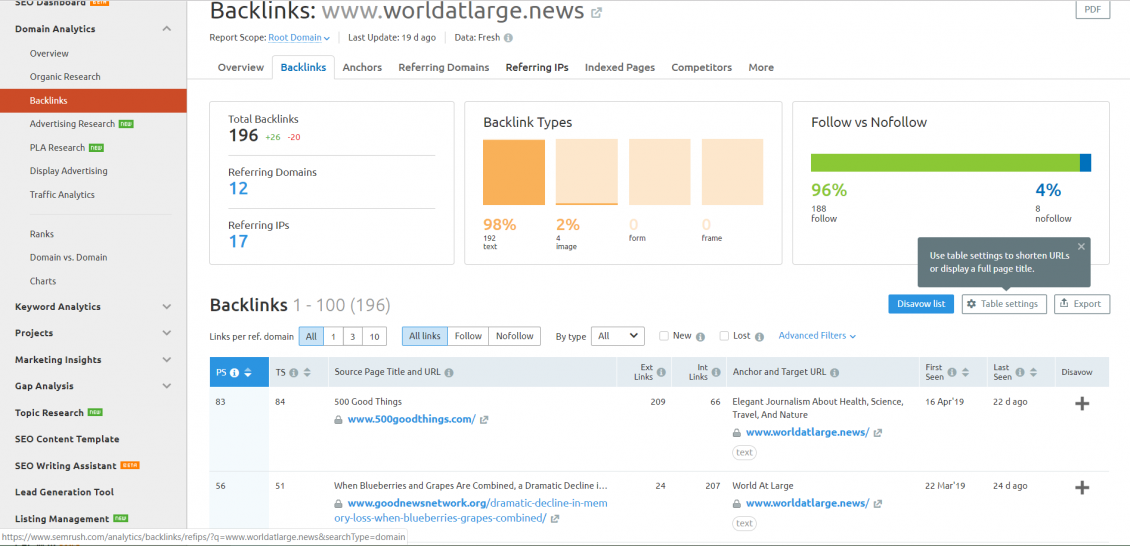
PICTURED: The backlinks reporting tool within SEMrush, where the content marketer can look at all the referring domains and links leading back to his platform from elsewhere. In the middle of the slide you can see the breakdown of where the links are placed, and along the bottom you can see the rankings of each link, which platform they’re on, and how they’re performing.
Backlinks denote authority, because they represent a publisher referencing your content as means to prove a point.
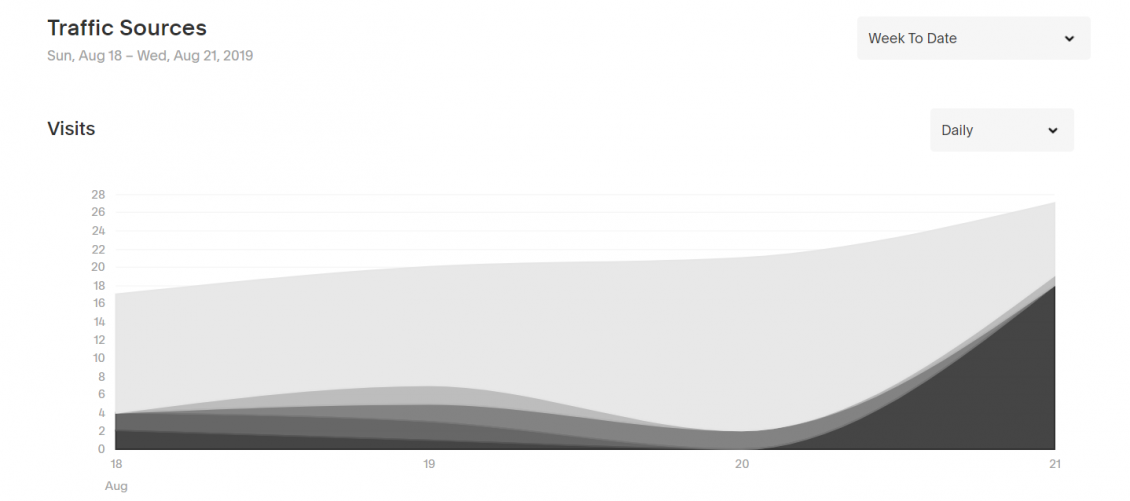
PICTURED: The traffic source reporter on a typical Squarespace website admin page, wherein the traffic sources are denoted in the shades of grey. From lightest to dark it follows thusly: direct organic traffic, social media traffic, search engine traffic, email campaign traffic, and finally the darkest shade is referral traffic, which as we said early is another way of saying backlinks.
This website has a gotten a lot of referrals – that’s because it has just published an article off-platform with backlinks in place that send readers to the content marketers website.
The only reason any of that traffic arrived at that website was because someone managed to either
A) Get some content published off-platform
Or…
B) Generate such good quality content and earn the favor of so many people through other means that they naturally become an authority within a given space.
Can you generate that much traffic on your own? Are people singling you out as a master based on your own merit? That’s a very difficult thing to achieve.
But for those just starting out, getting content off-platform helps expand traffic avenues and domain scores within search engines.
[insert page='how-to-balance-seo-and-ux-on-your-website' display='single-related-article-02.php']
More and more reasons to publish off-platform
Forgive me for being blunt, but does your website, platform, blog etc. receive a larger click-through-rate than say, the American Conservative? What about the Home Depot blog? Moths by NPR?
The obvious benefit of publishing off-platform is you run the chance of tapping into much vaster sources of traffic than you ever could pushing your own content along on your own platform.
Furthermore, you can add a name like those above on your professional CV in case of future employment opportunities.
Finally, you can use the success of being published on a large platform as a bit of a celebration to re-engage existing readers by reinforcing your role as an authority on a topic in their minds.
3 easy steps to getting published off-platform
STEP 1) Notebooks out; now open any old keyword ranking software like SEMrush or Google Keyword Planner and open a keyword research tool. The slide below is the keyword overview tool in SEMrush.com
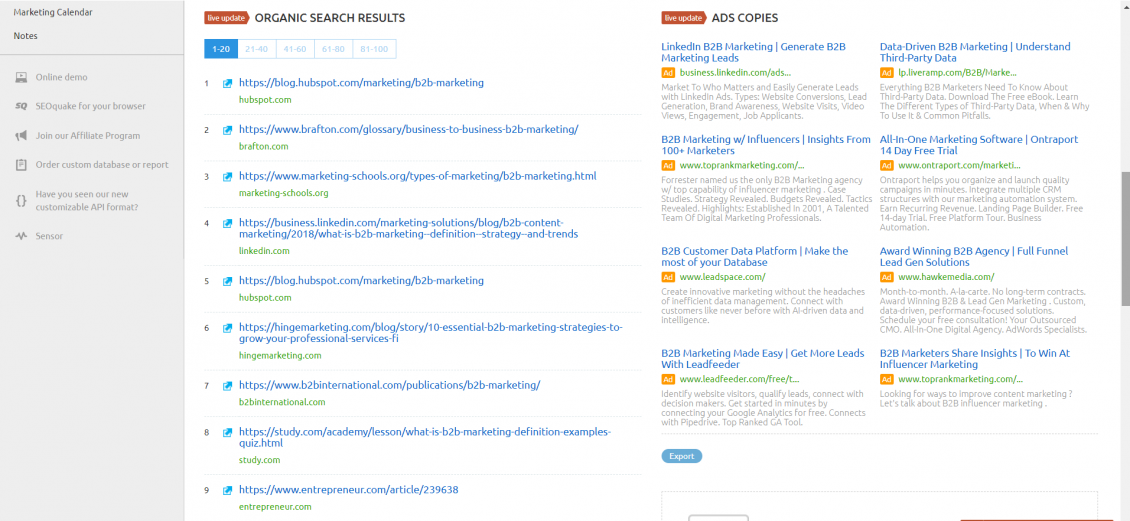
PICTURED: In this slide you can see the results for a “B2B Marketing” keyword overview search in SEMrush. Below useful metrics like how much traffic this keyword receives, and the performance of related keywords, you get a list of which ads and platforms are ranking well for that keyword. This image features the top twenty, but you can see increments of 20 going up to the 100th ranked platform.
STEP 2) Write down all the different platforms which rank well for the keywords you entered AND where you think you’d have a chance of having an article accepted. It doesn’t have to be an industry blog like blog.hubspot, but rather see if you can find magazines or news publications as well.
You can scroll back down the results to reach smaller platforms that will be more interested in hosting guest posts.
STEP 3) Write a solid article and shop it around to the websites you wrote down that accept guest posting or freelance writers.
Have a good pitch, like “I found this article on your website which did very well. You could use this one as a follow up to keep your readers engaged”. And by the way, you can use SEMrush to determine which of their stories or articles have done well.
Another great pitch is look through their articles within the last few months and see if any of the information contained therein is out of date.
“Hello. You have an article here on how to do proper SEO that doesn’t include *this major development in the field. I penned a quick draft that explains how important it is. Can I interest you in it?”
[insert page='seo-keywords-how-better-keyword-research-gets-you-better-results' display='single-related-article.php']
In Conclusion
Journalists, especially freelancers, live and die on their reputation. This isn’t as true today as it once was, but an inexperienced journalist who gets something majorly wrong is going to find it way harder to find work.
Content marketers can take a leaf out of the freelancer’s desire to ever expand their portfolio and CV and reputation by publishing stories across many different networks.
As we’ve said before, this can help by seeding the alleyways and gardens of the internet with links back to the content marketer’s own platform, as well as increasing the likelihood of tapping into much greater reserves of internet traffic by investing time onto platforms larger than one’s own.
Finally, it will please the Google-y overlords by seeing that you are considered in high regard by off-platform publishers, and will reward your knowledge and authority with higher rankings in the search engines.
Did you know that more than 130 trillion web pages have been indexed by Google? You don’t see most of them because they aren’t properly optimized. The competition is so fierce that if you don’t have a search engine optimization (SEO) plan in place, your site will get buried in the back of the search results. You know you need to find an SEO agency to handle your marketing, but you aren’t sure how to select one. Find out what makes a great SEO company so you can make your decision and get on with the business of rising up in the ranks.
Creative Yet Tactical
Top SEO companies understand the need to balance creative vision with tactical strategies to get results. Great marketing consists of stories that motivate people to take action, along with a plan to get those stories in front of potential customers. Find an SEO company that knows how to develop and tell a story while also understanding how to execute a successful marketing strategy.
[insert page='https://www.relevance.com/highly-actionable-pr-tactics-you-need-to-start-using-today/' display='single-related-article.php']
Transparent
Some marketing agencies like to pretend like they are going to wave a magic wand and transform your site. As mentioned earlier, marketing consists of a series of planned steps that are both tactical and creative, that are used to drive results. The best companies don’t hide behind a curtain, refusing to tell clients what they are doing. Instead the best companies explain the marketing plan to their clients and then provide them with analytics so they can view the results for themselves.
Realistic
When you search for SEO companies, you’ll notice that many of them will promise you the moon as well as the stars. They might say they can get you to the top spot on Google in a month or will triple your traffic in a week. These are empty promises used to get people to sign contracts. Quality Search Engine Optimization (SEO) takes time, work, and patience. Choose an SEO company that is realistic. Such a company will tell you what it will do to help you reach your goals, all while explaining that it won’t happen overnight.
Proficient in Local SEO
If you run a local business, you also need to consider a firm’s local marketing abilities. Some SEO companies do global marketing, while others specialize in local SEO efforts. Local SEO tactics are necessary if you’re going to drive traffic to your brick and mortar business or generate phone calls for your services.
A Willingness to Change and Adapt
When looking for an SEO company, select one that realizes that marketing is constantly evolving. Some companies choose to set up a marketing campaign and leave it. However, campaigns need to be tweaked on a regular basis based on analytics and overall performance. This is the only way to reach your goals.
Make a Smart Choice When Selecting a Company
Look for all these qualities when choosing a marketing company. Make sure you ask questions about what they offer and what they can do to create a customized campaign for you and help you reach your goals. Use these questions as a way to assess how creative, tactical, realistic, and knowledgeable they are.
Ever since search engines rose to prominence in the marketing world, the battle between SEO and website user experience (UX) has been raging, each championing their own priorities for web design. For website owners, taking into account the guidelines for search engine optimization and the best practices for a positive user experience can feel like serving 2 masters. After all, you want your site to be full of content and keywords to help search engines find you, but you also want your site to be easy to navigate and to convert visitors to customers. Is there a happy medium? Rest assured, solutions are at hand. Follow these 5 tips to balance the demands of SEO and UX on your site.
Appeal to Search Engines & Deliver a Great User Experience
1. Be Strategic with High-Level Messaging
High-level messaging on a web page typically refers to the headlines, subheadings and calls to action. This messaging has two functions. It anchors and guides your visitor’s attention through the site, and it also supports on-site optimization, so this is a great place to start.
From a UX-standpoint, web designers use visual hierarchy, that is, they arrange the graphic elements in order of importance. The goal of visual hierarchy is to influence the order in which the human eye perceives information. Headline texts are typically in the largest font, with subheadings in slightly smaller fonts. This helps a web visitor to process information quickly as they scan the page.
From an SEO perspective, the main headline on a web page is typically the H1 tag. H1 is an HTML tag that indicates a heading on a web page to the search engines. Before working on your high-level messaging, do some keyword research and think about the focus of each page. Be strategic and include keywords in your headline, while keeping the language clear and accessible. Your visitors will be able to tell the difference between useful, informative headlines and overstuffed, keyword-laden headlines just for optimization purposes.
[insert page='leverage-ux-best-practices-to-10x-your-conversions' display='single-related-article-02.php']
2. Present Content in Creative Ways

One of the big battles between SEO experts and UX strategists is over the amount of content to have on a web page. You need enough content so that the search engines can understand what the page focuses on, but you also need to be clear and concise enough so that your visitors stay engaged.
If a particular page calls for a lot of content, get creative about where and how you place the information. On your home page, the first 4-5 panels or sections of the page should correlate to the most important pages of your site. Because web visitors tend to scroll on websites, it’s common for a visitor to scroll through the home page and use it as a gateway into the internal pages. After these key panels on the home page, add a few more sections with less essential but useful content in order to increase the amount of content on the page.
On internal pages, a Frequently Asked Questions panel with an accordion is a great way to add more content while keeping a web page clean and easy to read. An accordion hides the answer to a question and only opens up to reveal the answer when a visitor clicks on the question or a plus symbol. It’s not only a user-friendly solution but keeps the content searchable to search engines as well.
3. Create a Clean Navigation
A clean, intuitive navigation is a critical part of creating a positive user experience on a website. If a web visitor has a difficult time navigating the website, it’s unlikely that they’ll stick around. In the past, websites were designed with lots of pages in the navigation because visitors were viewing sites on desktops and didn’t mind clicking through drop down menus.
Today, the majority of visitors view websites on smaller devices and expect to find what they are looking for as quickly as possible. For your SEO goals, you may want lots of pages on your website - but you don’t necessarily need all of those pages in your navigation. Avoid having lots of drop downs in the menu; they’re especially difficult to navigate on smaller devices.
If you have a larger site and need to showcase lots of service or product pages, consider adding a mega menu to the navigation. There are different types of mega menus and they offer a more expansive drop down interface for visitors.
[insert page='elevate-your-websites-ux-with-these-personalization-tactics' display='single-related-article.php']
4. Use Your Blog
Having an active blog supports both SEO and UX. From an SEO standpoint, a blog is an easy way to add new content to your website on a consistent basis, which search engines value. Strategically creating long-form articles focused on certain keywords also supports search engine rankings, as does linking internally between different blog posts on your site.
On the UX side of things, a blog is a visitor-friendly tool for organizing information. Rather than putting content into tons of pages that are difficult to find and navigate, place this content in blog posts. You can organize your information by categorizing the blog posts and adding tags. Implementing a search field for your blog is another way to help visitors easily access the information they’re looking for.
Lastly, video blogs are a great way to generate consistent posts. You can film several videos at the same time and then post each one separately. However, make sure that you write and post the transcription of the video along with embedding the video file. Search engines aren’t able to crawl videos, so you need to include the transcript.
5. Focus on Mobile

The mobile user experience is one area where SEO and UX are slowly converging. In 2016, Google announced mobile-first indexing, which means that Google predominantly uses the mobile version of your website for indexing and ranking. Mobile-first indexing is now extremely prominent, so you need to consider the mobile experience of your site for both SEO and user experience.
For this reason, it’s important to add content in strategic ways that optimize the mobile experience of your site. When designing your website, work with a web designer that is skilled with mobile-wise design.
A mobile-wise approach factors in how all the content, images and elements look on different device sizes from the outset. The placement of objects and the use of white space are both critical on mobile because visitors tap buttons or links with their thumb. If objects are too close together, your site will be difficult to navigate on a smaller device.
Finally, we’ve all seen people walking and looking down at their phone. Creating an intuitive navigation and experience is so important on mobile because your visitor’s attention may be fragmented while they try to navigate the site.
[insert page='why-a-free-seo-tool-junkie-finally-joined-the-paid-club' display='single-related-article-02.php']
You Can Achieve a Balance
In the end, a little bit of forethought is all you need to resolve the battle between SEO and UX.
With clear, SEO-savvy messaging, a robust blog, and clean mobile-wise navigation and content layout, you can satisfy both SEO protocol and maintain a friendly and accessible UX.
By focusing on these 2 elements, you can not only improve your search engine results but also engage and convert the traffic in the end. There’s no need to divide your loyalty between the two goals. Properly balance your SEO and UX, and you can have it all.

